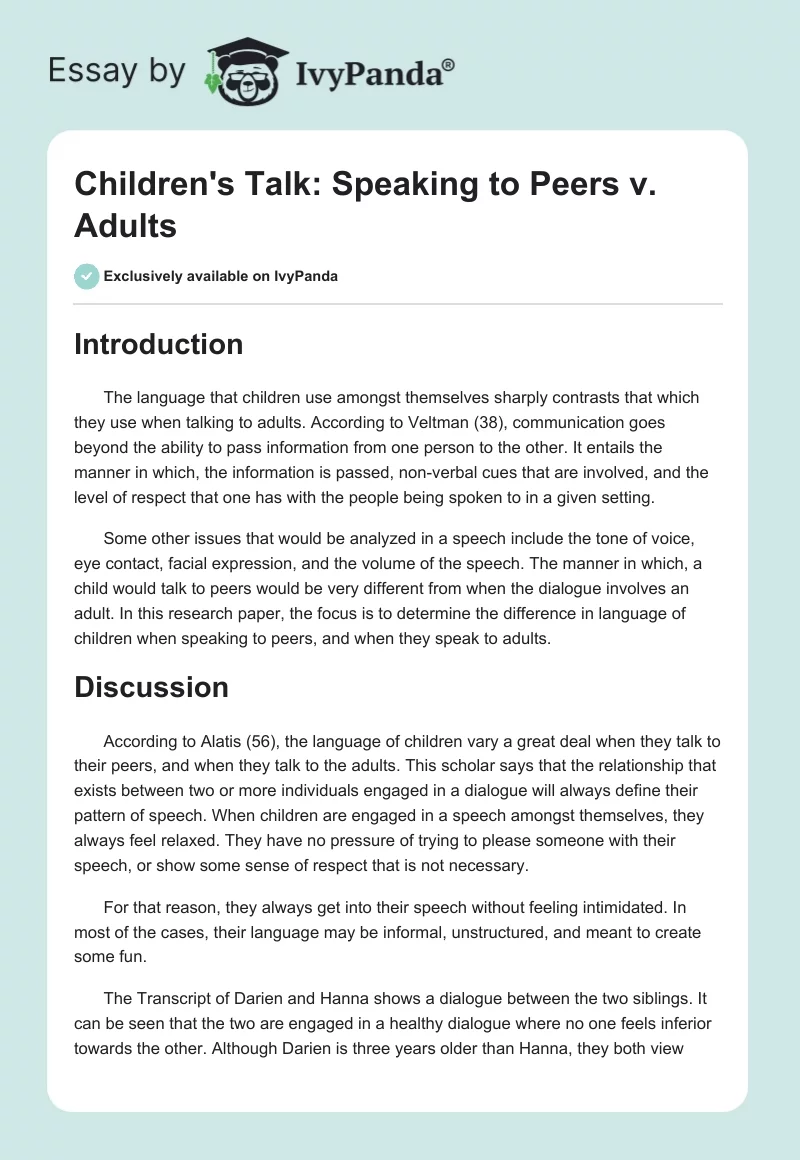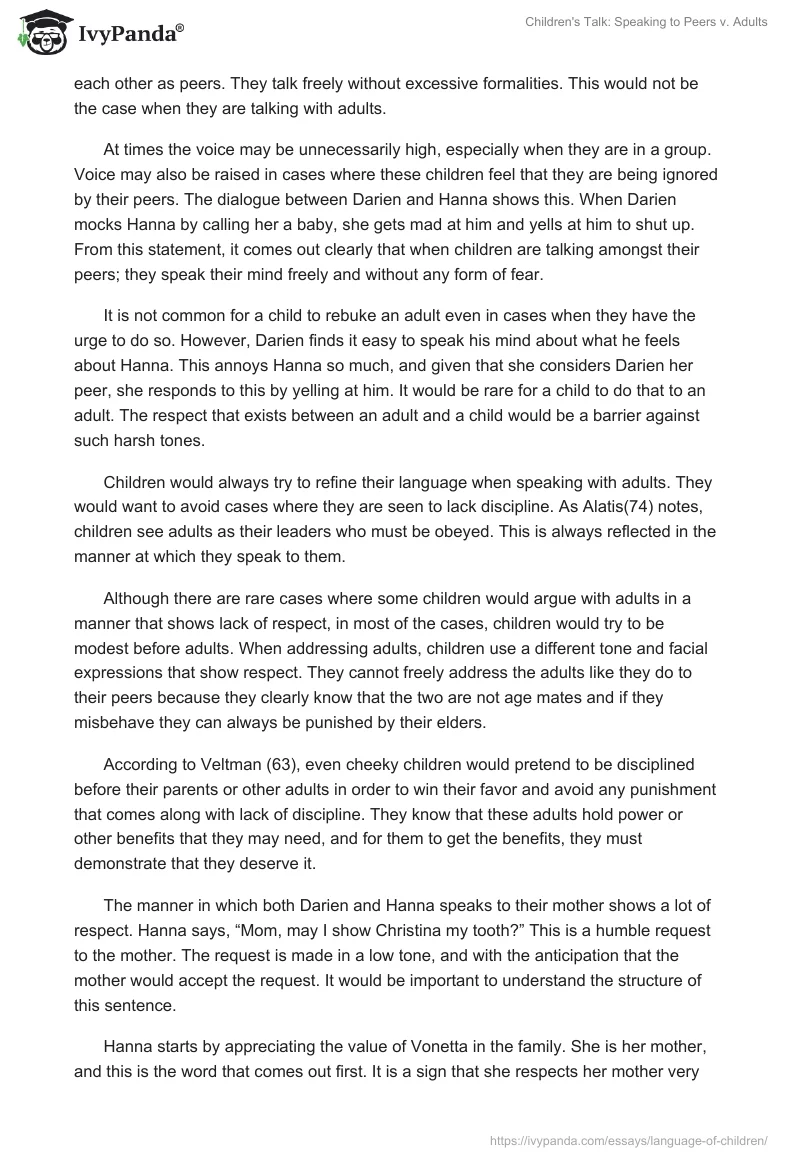Introduction
The language that children use amongst themselves sharply contrasts that which they use when talking to adults. According to Veltman (38), communication goes beyond the ability to pass information from one person to the other. It entails the manner in which, the information is passed, non-verbal cues that are involved, and the level of respect that one has with the people being spoken to in a given setting.
Some other issues that would be analyzed in a speech include the tone of voice, eye contact, facial expression, and the volume of the speech. The manner in which, a child would talk to peers would be very different from when the dialogue involves an adult. In this research paper, the focus is to determine the difference in language of children when speaking to peers, and when they speak to adults.
Discussion
According to Alatis (56), the language of children vary a great deal when they talk to their peers, and when they talk to the adults. This scholar says that the relationship that exists between two or more individuals engaged in a dialogue will always define their pattern of speech. When children are engaged in a speech amongst themselves, they always feel relaxed. They have no pressure of trying to please someone with their speech, or show some sense of respect that is not necessary.
For that reason, they always get into their speech without feeling intimidated. In most of the cases, their language may be informal, unstructured, and meant to create some fun.
The Transcript of Darien and Hanna shows a dialogue between the two siblings. It can be seen that the two are engaged in a healthy dialogue where no one feels inferior towards the other. Although Darien is three years older than Hanna, they both view each other as peers. They talk freely without excessive formalities. This would not be the case when they are talking with adults.
At times the voice may be unnecessarily high, especially when they are in a group. Voice may also be raised in cases where these children feel that they are being ignored by their peers. The dialogue between Darien and Hanna shows this. When Darien mocks Hanna by calling her a baby, she gets mad at him and yells at him to shut up. From this statement, it comes out clearly that when children are talking amongst their peers; they speak their mind freely and without any form of fear.
It is not common for a child to rebuke an adult even in cases when they have the urge to do so. However, Darien finds it easy to speak his mind about what he feels about Hanna. This annoys Hanna so much, and given that she considers Darien her peer, she responds to this by yelling at him. It would be rare for a child to do that to an adult. The respect that exists between an adult and a child would be a barrier against such harsh tones.
Children would always try to refine their language when speaking with adults. They would want to avoid cases where they are seen to lack discipline. As Alatis(74) notes, children see adults as their leaders who must be obeyed. This is always reflected in the manner at which they speak to them.
Although there are rare cases where some children would argue with adults in a manner that shows lack of respect, in most of the cases, children would try to be modest before adults. When addressing adults, children use a different tone and facial expressions that show respect. They cannot freely address the adults like they do to their peers because they clearly know that the two are not age mates and if they misbehave they can always be punished by their elders.
According to Veltman (63), even cheeky children would pretend to be disciplined before their parents or other adults in order to win their favor and avoid any punishment that comes along with lack of discipline. They know that these adults hold power or other benefits that they may need, and for them to get the benefits, they must demonstrate that they deserve it.
The manner in which both Darien and Hanna speaks to their mother shows a lot of respect. Hanna says, “Mom, may I show Christina my tooth?” This is a humble request to the mother. The request is made in a low tone, and with the anticipation that the mother would accept the request. It would be important to understand the structure of this sentence.
Hanna starts by appreciating the value of Vonetta in the family. She is her mother, and this is the word that comes out first. It is a sign that she respects her mother very much. The second word is “may I”, which is a humble request made towards the mother. It shows that Hanna appreciates that her mother deserves the right to accept or reject the request.
The mannerism with which this statement is made also shows the respect that this little girl has towards the adults. She would have opted to show Christina her tooth without seeking for permission. However, she prefers to seek for permission from her mother first. Such quality of respect disappears when talking to the brother. She even yells at him, something that she cannot do when talking to the other two adults.
It is common to find children competing to speak when they are among their peers. Everyone would want to be listened to in such group contexts. However, this changes when they are talking to adults. Turn taking in speaking is very common when children are talking to the adults. They will only talk when responding to a question, giving an explanation, or making a request. It is also rare for children to engage adults in an argument where everyone is trying to be heard.
Conclusion
Children always know the way they address their fellow peers is not the same way to address their parents or other adults. They can use harsh tones to other peers because they know very well that they will not be punished or humiliated in any way. They do not need to request for any favors from their peers hence are comfortable using any tone to address them provided the message is passed.
This is totally different when communicating to their elders. Children have special respect for the adults in the community. They will always beg, request and do everything to their parents or other adults to get favors. They cannot dare raise their voice or engage in an argument with the adults.
Works Cited
Alatis, James. Strategic Interaction and Language Acquisition: Theory, Practice and Research; Georgetown University Round Table on Languages and Linguistics. DC: Georgetown Univ.-Press, 1993. Print.
Veltman, Calvin. Language Shift in the United States. New York: Mouton, 1983. Print.


